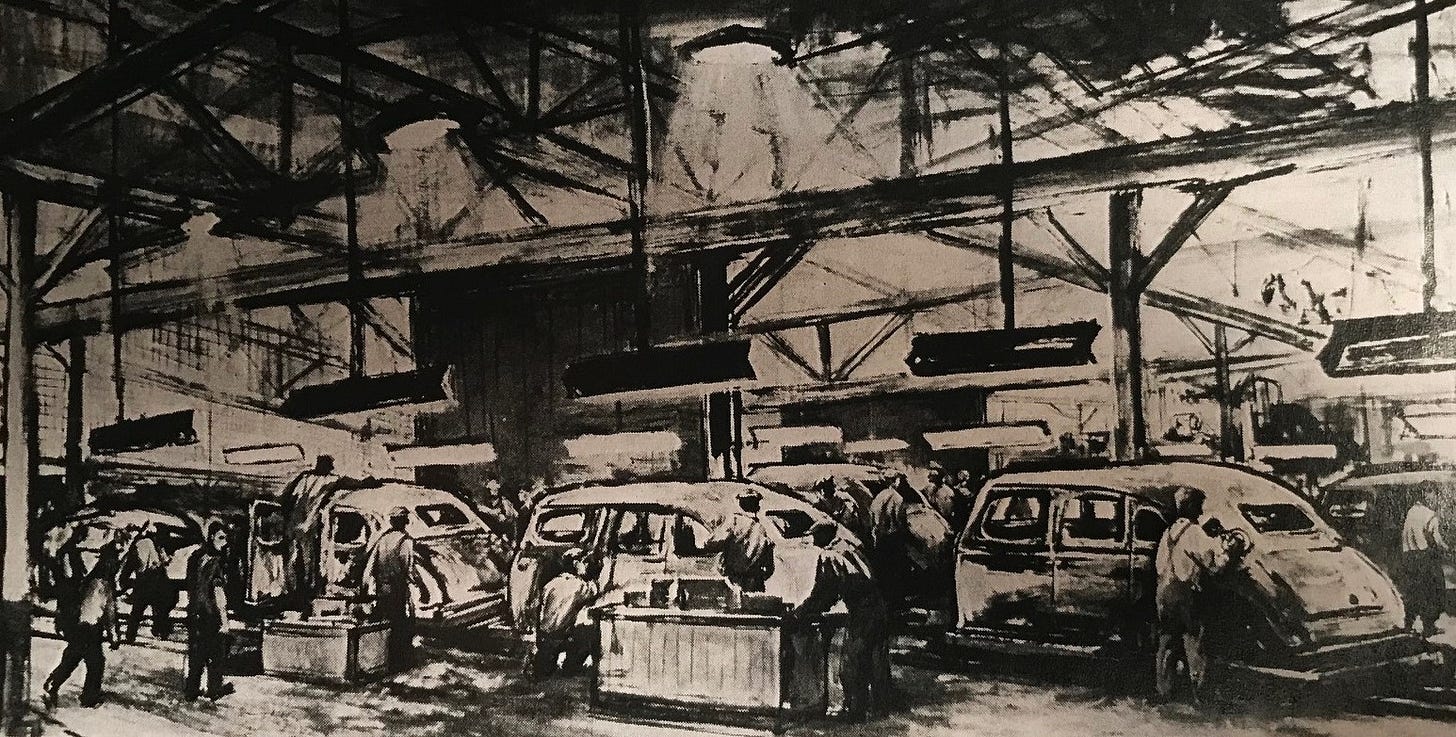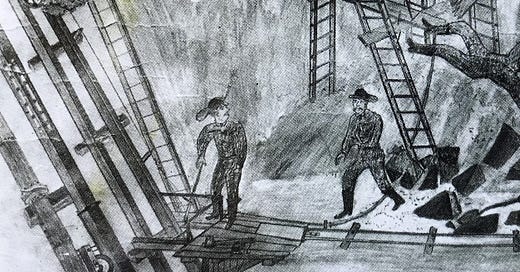Part Five: - One Hundred Years of Michigan Work in Art: 1850 to 1950
The Michigan Worker on Land and Below
The ignition of a cave-in is the subject of a primitive, unsigned watercolor (ca. 1880) in the collection of the Michigan Historical Museum. With the deceptively mild title “Cleveland Iron Mine No. 1,”[i] it depicts a miner falling from a scaffold where he’s been operating a rock drill. Rocks dislodged from the drilling rain down as miners rush from the immediate danger to whatever “safety” is available to them a mile below the surface of the earth.
Safety wasn’t easy for Michigan workers to find above ground either. Though the gigantic presses look relatively benign, almost architectural, in University of Michigan art professor Carlos Lopez’s painting “Stamping Presses—Fisher Body Plant, Pontiac,”[ii] in James Steele’s 1935 novel Conveyor these presses relentlessly drive their operators to tragedy [iii]:
[Marie’s] foot tripped on and off the pedal, her hands flashing in and out under the press block. She must be careful, see that she made no scrap, or break a die—if she did she’d get sent home, or fired maybe…the press block sped down, the dies came together on the metal, up went the block as the compressed air hissed the piece off the die, and in went the next piece of metal. So it went—in with the metal, out with the fingers as the upper die sped down—1,007 pieces out so far…in with the metal, out with the fingers—OUT!—For a moment her arm was dull as the bone crackled under the impact. Then the block rose, bloody. She staggered from the stool. Flywheels whirled in her face. The presses roared in her ears, crushing her. Pain burst in flaming fragments up her arm.[iv]
In Lopez’ “Painting and Polishing Car Bodies”[v] the assembly line bears scant resemblance to the chaos of the paint line that Steele describes in Conveyor:
The bodies flashed past—160, 170, 175—and still the job setters were shouting….The sanders, stripped to the waist, had rubbed their fingers bloody on the metal; the polishers were breathless from the speed…. ‘Step on it, Jesus Christ, step on it!’ [vi]

The workers in Lopez’ paintings are faceless, but not inhuman, focused, but not frantic; the work process appears orderly and unhurried. In neither painting are line bosses shown badgering the workers. In contrast, “Assembly Line” by line-worker-turned-fine-artist Jack Keijo Steele (1919-2003) portrays a frantic work pace: slashing red and white brushstrokes blur the workers and machines in his 1954 painting.[vii]
The worker in the center of the painting, his back to the viewer, appears bent by a gale-force wind—a force he cannot withstand indefinitely. “Assembly Line” might as well have been a portrait of the hapless “Jim” from Conveyor:
Never a stop. Never a moment’s hesitation—in with the rod, pull, release, in pull, release, minute after minute, hour after hour, his muscles working with the machine as though a part of it…16, 17 pans, and still he kept the pace…Eighteen pans a day! Over a thousand rods an hour, 18 a minute! One rod every three and a third seconds!
‘Goddam if I’ll make it,’ Jim vowed as he walked out of the plant…
But Jim did make it. He had to make it. The Rivers Motor Company took care of that.[viii]
Though formal portraits were more often a perquisite of wealthy industrialists, the genre was used brilliantly by Michigan artists Fredenthal and Sepeshy to honor anonymous working men. The subject of Fredenthal’s watercolor “Foundry” is a nameless figure pouring molten metal into a mold. Though the worker’s full body takes up nearly the entire canvas, the viewer’s focus is drawn to his massive bicep, placed dead center in the painting. With his back, hips, and legs bent in a powerful but awkward zigzag, the foundryman pits his strength and stamina against the weight of the ladle. The painful awkwardness of the pose highlights his determination and foreshadows his defeat.
The gently curving lines in Sepeshy’s ink-and-pastel portrait “Ishpeming” convey the slackness of an iron miner at rest. The man is faceless and of indeterminate age, and his lassitude is conveyed through the downward curve of his mouth and slope of his shoulders. His eyes are in the shadow of his miner’s helmet, and his right arm hangs at his side, weighed down by the heavy hammer in his hand. Only a small triangle of blue in the upper right of the composition relieves the dull palette of tans and grays. The title “Ishpeming” provides only the location of the nameless man; the viewer doesn’t even know if he’s coming to work or leaving it—an ambiguity that illustrates the man’s ambivalence towards either.
Part Six of this series will continue with “Michigan Women at Work.”
[i] Thomas G. Friggens, “Hard Rock and Iron Souls,” Historical Society of Michigan Chronicle 34, no. 2 (Summer 2011), 20.
[ii] Florence Davies, Michigan on Canvas: The J.L. Hudson Company Collection (Detroit: J.L. Hudson Co., 1948), 15.
[iii] “James Steele” was the penname of Robert Lunan Cruden (1910-2004).
[iv] James Steele, Conveyor: A Novel (New York: International Publishers, 1935), 211-12.
[v] Davies, 24.
[vi] Steele, 17.
[vii] Michael D. Hall and Pat Glascock, Great Lakes Muse: American Scene Painting in the Upper Midwest, 1910-1960 (Flint, MI: Flint Institute of Arts, 2003), 110.
[viii] Steele, 208-09.








